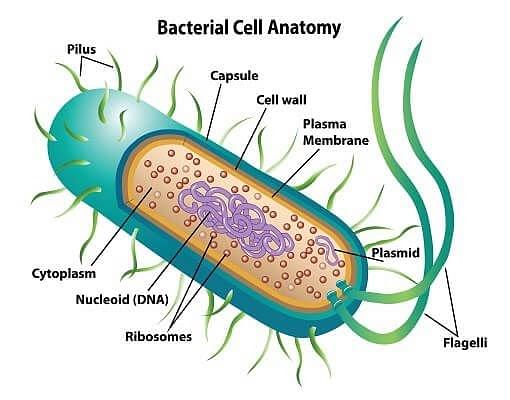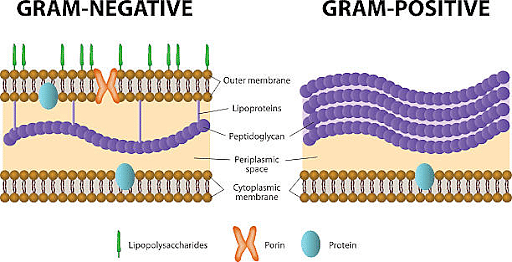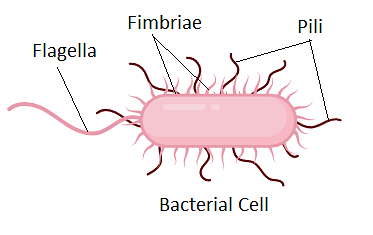What Characteristics Do Eubacteria Have
Definition of Eubacteria
[Click Hither for Sample Questions]
Eubacteria are single-celled prokaryotic microorganisms and are also known as the "true" bacteria that take a variety of characteristics that can be plant under various environmental conditions all over the world. Almost all kinds of bacteria autumn under this, except archaebacteria.

Eubacteria
Eubacteria can form spores and it can cause illness in humans every bit well as in animals (they can be pathogenic organisms). The mode of reproduction in Eubacteria is through binary fission or by budding, they tend to class large colonies that create "biofilms" i.e. extracellular structure that helps to protect the colony in unique ways. There are mainly three types of eubacteria based on their shapes:
- Bacilli
- Cocci
- Spirilla
Whereas Eubacteria are classified or we tin say are typically classified as:
- Gram-Positive
- Gram-Negative
- Miscellaneous
Also Read:
Types of Eubacteria
[Click Here for Previous Years Questions]
In that location are three types of bacteria that are mainly classified based on the shape they take: Bacilli, Cocci, Spirilla. The shapes of bacteria are ofttimes used every bit a classification organisation. Bacteria are linked afterward the partitioning, forming different shapes and structures such as clusters, filaments, and tight coils. Let us talk over the three shapes in detail.
- Bacilli: They are rod-shaped bacteria.
- Cocci: They are spherical in nature.
- Spirilla: They tend to have spiral or wave-shaped structures in nature.

Classification of leaner based on their shapes
Eubacteria are typically classified based on different factors such as,
- Gram-positive
- Gram-Negative
- Miscellaneous Eubacteria
Every bit at that place are numerous phyla of eubacteria under the domain bacteria, these relationships are switching constantly and are still defined based on new DNA experiments. The outer membrane of the bacteria is an boosted layer that surrounds the cell walls of bacteria.
When this additional layer cannot be stained with gram- stain, they are known as Gram-negative bacteria. These bacteria incorporate sure species that are harmful to humans.
Those bacteria which tin be seen with the help of gram stains are known as Gram-Positive bacteria and they are either harmless or beneficial to human health.

Gram-Positive and Gram-Negative Bacteria
Characteristics of Eubacteria
[Click Hither for Sample Questions]
- Eubacteria is as well known equally the "truthful bacteria."
- Peptidoglycans grade the potent prison cell wall in Eubacteria.
- Flagella are used for locomotion.
- A few bacteria have pili, which are small appendages on the surface of the cell that helps or help the leaner in sexual reproduction. Pili too helps or assists in the attachment of pathogens to their hosts.

Pili in Bacteria
- Depending on the type of the cell wall and the gram stain they take, they are classified as gram-positive or gram-negative. where gram-negative is harmful to humans and gram-positive is beneficial to human health.
- The 2 examples of eubacteria are Rhizobium and Clostridium.
Read more :Saprophytes
Fashion Of Nutrition of Eubacteria
[Click Here for Previous Years Questions]
Way of diet in Eubacteria is heterotrophic, but both the organisms, be it autotrophic or heterotrophic organisms feed on eubacteria. Heterotropic are those who eat food from other plants, organic carbon sources, or animal matter whereas autotrophs are those who produce their nutrient through the process of photosynthesis.
Read more :Lichens
Examples of Eubacteria
[Click Here for Sample Questions]
Some examples of Eubacteria are streptococcus pneumonia which causes pneumonia infection in humans. Lactobacillus, which is present in our gut, is a good leaner. Some more examples of typically classified leaner are proteobacteria, Cyanobacteria, chlamydias, spirochetes.

Eubacteria in Humans
Read more : Mycorrhiza
Things of Call back
[Click Here for Previous Years Questions]
- Eubacteria are single-celled prokaryotic microorganisms and are likewise known as the "true" leaner.
- The mode of reproduction in Eubacteria is through binary fission or past budding.
- In that location are three types of bacteria that are mainly classified based on the shape they take: Bacilli, Cocci, Spirilla.
- Eubacteria are typically classified on the basis of different factors i:due east Gram-positive, Gram-Negative , and Miscellaneous Eubacteria.
- Gram-negative is harmful to humans and gram-positives are benign to man health.
- Some examples of Eubacteria are streptococcus pneumonia, Lactobacillus, proteobacteria, blue-green alga, chlamydias and spirochetes.
Also Read:
Previous Year Questions
- The taxonomic unit phylum in the nomenclature of animals is… [UPSEE 2016]
- Prison cell wall is absent-minded in… [NEET 2015]
- Membrane-bound organelles are absent in… [NEET 2010]
- A free living nitrogen-fixing cyanobacterium which can as well… [NEET 2004]
- Which fungal disease spreads by seed and flowers… [NEET 2002]
- Friction match Cavalcade - I with Cavalcade - Two… [NEET 2019]
- The thalloid trunk of a slime mould (Myxomycetes) is known every bit… [NEET 2006]
- At that place exists a close clan between the alga… [NEET 2005]
- After karyogamy followed by meiosis, spores are produced… [NEET 2018]
- Archaebacteria differ from eubacteria in… [NEET 2014]
- Azotobacter and Bacillus polymyxa are the examples of… [NEET 1996]
- Bacteria lack alternation of generation because at that place is… [NEET 1991]
- Bacterial leafage blight of rice is caused by a species… [NEET 2008]
- Barophilic prokaryotes… [NEET 2005]
- BGA (blue green algae) are included in which of the following groups… [NEET 1996]
- Which blazon of Deoxyribonucleic acid is constitute in bacteria?….[NEET 1996]
- Lichens abound by….[NEET 1996]
- Which of the post-obit is free-living aerobic and ...[NEET 1997]
- Genophore/bacterial genome or nucleoid is made of…..
- Bacteria lack alternation of generation because at that place…..[NEET 1991]
Sample Questions
Ques. What are the differences between Archaea and Eubacteria? (two marks)
Ans. Differences between Archaea and Eubacteria are:
| Eubacteria | Archaea |
|---|---|
| Single-celled elementary organisms. | Unmarried-Celled complex organisms. |
| Capable of living in farthermost conditions. | Capable of living in normal conditions. |
| Reproduction is through asexual methods. | It can reproduce by both sexual and asexual methods. |
Ques. Ascertain Eubacteria. Give two examples of Eubacteria. (2 marks)
Ans. Eubacteria are single-celled prokaryotic microorganisms and are also known equally the "true" leaner that have a variety of characteristics that tin be found under various environmental conditions all over the world. Almost all kinds of bacteria fall nether this, except archaebacteria. Eubacteria can form spores and information technology can cause disease in humans as well as in animals ( they can be pathogenic organisms ). The way of reproduction in Eubacteria is through binary fission or by budding, they tend to grade large colonies that create "biofilms" i:due east extracellular structure that helps to protect the colony in unique ways. Examples of Eubacteria are: Streptococcus pneumonia, and Lactobacillus.
Ques. What are the types of eubacteria on the ground of their shape. Explicate? (three marks)
Ans.There are mainly three types of eubacteria based on their shape. The shapes of bacteria are often used every bit a classification system. Bacteria are linked after the division, forming different shapes and structures such equally clusters, filaments, and tight coils. :-
- Bacilli: They are rod-shaped leaner.
- Cocci: They are spherical in nature.
- Spirilla: They tend to have spiral or moving ridge-shaped construction in nature
Ques. Write three Characteristics of Eubacteria. (3 marks)
Ans.Three characteristics of Eubacteria are as follows:
- Peptidoglycans course the potent prison cell wall in Eubacteria.
- Flagella are used to help it to move.
- A few leaner have pili, which are minor appendages on the surface of the cell that helps or assist the bacteria in sexual reproduction. Pili also helps or assists in the zipper of pathogens to their hosts.
Ques. What is the mode of diet of Eubacteria. (2 marks)
Ans. The well-known way of nutrition in Eubacteria is heterotrophic, simply both the organisms, be it autotrophic, or heterotrophic organisms both feed on eubacteria. Heterotropic are those who consume food from other plants, organic carbon sources or animate being matter whereas autotrophs are those who produce their food through the process of photosynthesis.
Ques. Explain Gram-negative and Gram-positive eubacteria. (ii marks)
Ans. The outer membrane of the leaner is an additional layer that surrounds the cell walls of bacteria. This additional layer cannot be stained with gram- stain. Due to this reason, they are known as Gram-negative. These bacteria contain sure species that are harmful to humans. Those bacteria which tin can be seen with the help of gram stains are known every bit Gram-Positive bacteria and they are either non-harmful or benign to human wellness.
Ques. How is Eubacteria unlike from archaebacteria. (ii marks)
Ans. Eubacteria and Archaebacteria are ii chief divisions within the prokaryotic organisms. Eubacteria are also known as the true bacteria and are normally found in the domain leaner, whereas archaebacteria are commonly constitute in the domain Archaebacteria. Eubacteria are single-celled prokaryotic microorganisms with a multifariousness of characteristics that are or tin be plant in a diverseness of environments around the whole world.
Ques. What is the role of bacteria in increasing soil fertility? (2 marks)
Ans. Some bacteria, which are present in the root nodules of leguminous plants or complimentary-living, fix the atmospheric nitrogen in the soil which is ultimately used up past the plants. Hence they increase the fertility of the soil. For example, Rhizobium, Azotobacter, Azospirillum, etc.
Ques. Explain why antibiotics exercise non work against influenza or any infection caused by viruses. (2 marks)
Ans. Viruses cannot be killed by using antibiotics as their prison cell pathways are unlike from that of bacteria. Information technology means taking antibiotics to get rid of influenza or any other viral infection is useless, because information technology does not reduce the strength of the virus, nor does it reduce the duration of the infection. But, even so, antibiotics volition work if we get attacks of viral infection and bacterial illness at the aforementioned time. Even then, it volition cure bacterial illness but but not a viral infection.
Ques. Explain canning. (2 marks)
Ans. Canning is a procedure used for nutrient preservation. Heat, at a certain temperature and for a express period of time, is used to kill harmful microorganisms as well as enzymes. This method also involves the removal of oxygen gas and avoiding post-process contamination by airtight sealing of food items.
Ques. What is the action mechanism of the antibiotic penicillin?(2 marks)
Ans.Penicillin, discovered by the Scottish physician Alexander Fleming in 1928, is a drug that inhibits enzymes necessary for the synthesis of peptidoglycans, a constituent of the bacterial cell wall. With the inhibition, the bacterial population stops growing because there is no new cell wall germination.
Ques. Bacteria are prokaryotic cells, i.e., they do not have a membrane-delimited nucleus. Eukaryotes have cells with a delimited nucleus. Where in these types of cells tin can DNA be constitute?(2 marks)
<
Ans. In eukaryotic cells, DNA is found within the cell nucleus. In prokaryotic cells, DNA is found dispersed in the cytosol, the fluid space inside the cell. Other DNA molecules tin can also be found within mitochondria and chloroplasts, specialized organelles of eukaryotic cells.
Ques. Are bacteria the only prokaryotic beings?(2 marks)
Ans. Prokaryotic beings are classified into ii large groups: archaebacteria and bacteria (this is besides known equally eubacteria). Compared to bacteria, archaebacteria have basic differences, like the chemical compositions of their plasma membrane and cell wall and different enzymes related to DNA and RNA metabolism.
Ques. Mention the types of parasexual methods used by eubacteria?(3 marks)
Ans.The three types of parasexual methods in eubacteria are transformation, transduction, and conjugation.
- Transformation is the process in which leaner takes up the foreign Deoxyribonucleic acid from its surroundings and gets transformed into another kind.
- Conjugation is the process in which F plasmid with fertility gene is transferred from one bacterium (the donor) to another with the aid of sexual practice hair.
- Transduction is the process of transfer of genetic materials from i bacteria to another through the bureau of bacteriophages.
Ques. What are the hyperthermophilic organisms growing in highly acidic (pH 2) habitats called?(iii marks)
Ans. Thermophiles live in very hot places, typically from 60° to 80°C. Many thermophiles (some eubacteria and archaebacteria) are autotrophs and have metabolisms based on sulphur. Some thermophilic archaebacteria form the footing of food webs around deep-sea thermal vents, where they must withstand extreme temperature and pressures. Archaebacteria tin can grow in highly acidic (pH =0.7) and very basic - (pH =11) environments.
Besides Read:
What Characteristics Do Eubacteria Have,
Source: https://collegedunia.com/exams/eubacteria-types-characteristics-mode-of-nutrition-biology-articleid-2934
Posted by: daviskniout.blogspot.com


0 Response to "What Characteristics Do Eubacteria Have"
Post a Comment